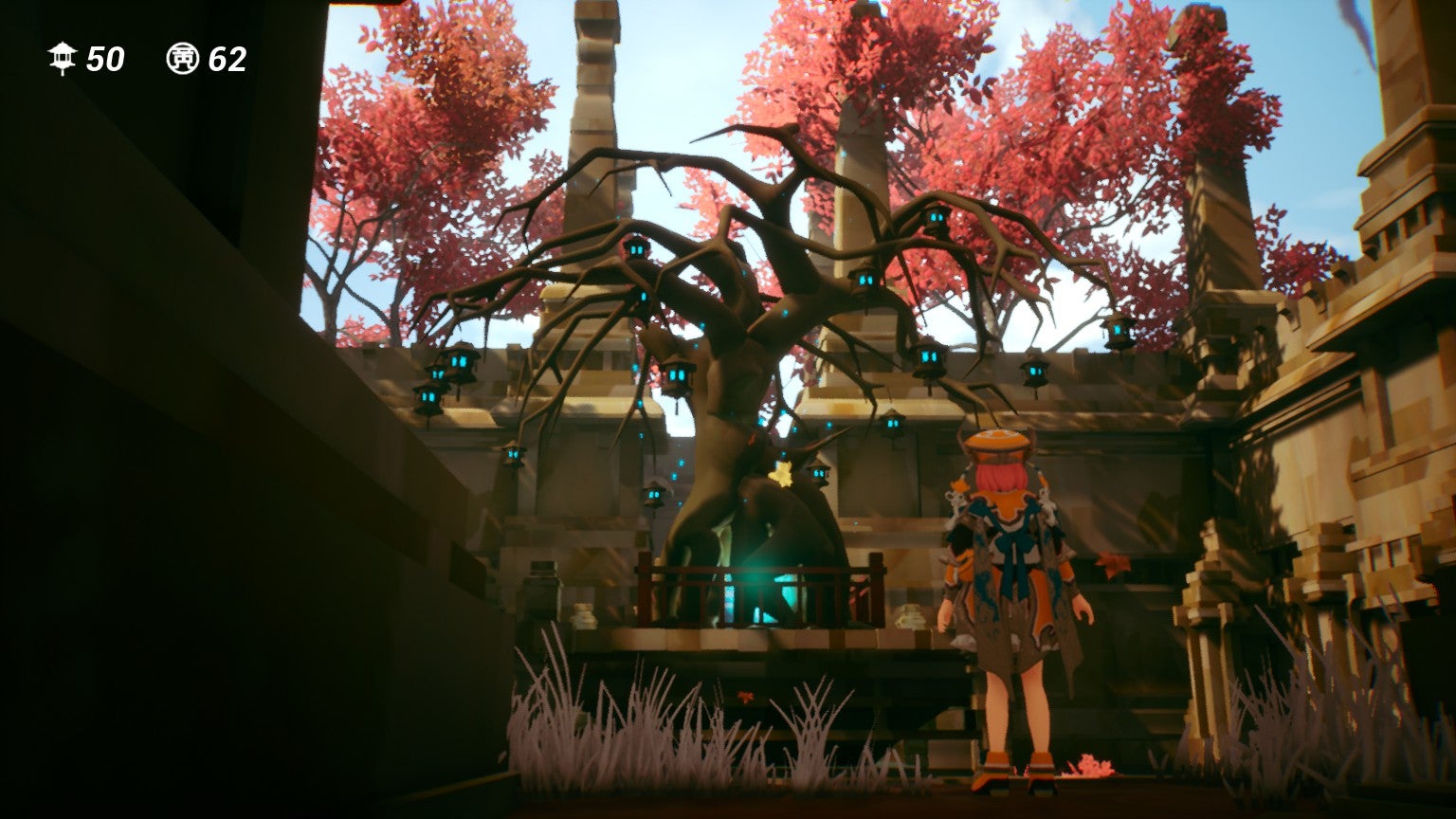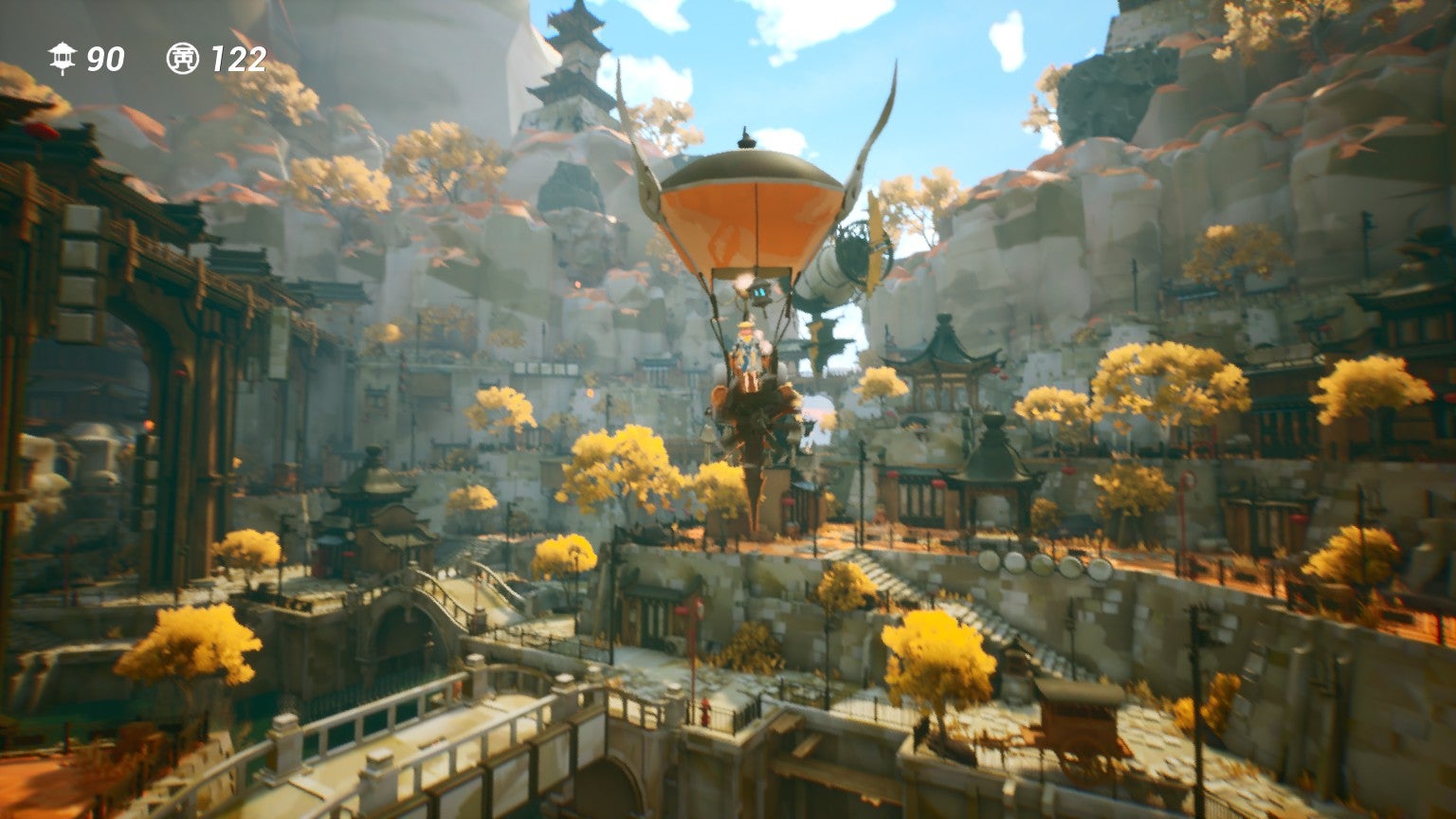If you’re looking for an attractive 3D fantasy world that doesn’t require a moment-to-moment tithe of blood, this is your game. The work of Tokyo-based indie nocras with a score from Youtube star Ujico*, it’s an idle afternoon in the daydreaming mind of a seasoned triple-A artist, whose credits include Zelda and Final Fantasy - a distillation of lessons learned while composing geography and architecture for grander, more combative experiences. It’s explicitly designed to be low-key, with no threats, no player death and no major goals beyond collecting things - an action it invests with a quiet intimacy that gently overpowers the element of repetition. It is the thinking behind A Short Hike applied to one of the towns from Breath of the Wild. Integral to Tasomachi’s charm is that it’s inconsequential. You play Yukumo, a nimble and usefully fall-damage-proof girl with a big hat, whose airship crashlands in the town of To-en during a trip along the coast. To-en, you soon learn, has succumbed to a mysterious magical fog. One of the resident cat-people advises you that to fix up your ship, you’ll need to lift this curse by gathering lanterns called Sources of Earth and seeking the blessing of Sacred Trees. And that’s pretty much all there is to this five-hour tale. Outside the game’s world, Yukumo could be anyone - a travelling sage or mercenary, a heroine of repute. There were times when I wondered, looking at her unblinking expression, if she was actually a villain of some kind - the footloose arch-nemesis of some epic narrative involving the creators of vases and balloons, which later puzzle quests ask you to destroy. But within the game, she’s just a girl interrupted on her way to somewhere else. Yes, she’s asked to save a world, but it’s a small world, and the calamity in question is really just a lingering case of bad weather. She’s not here to right any great wrongs, but help a bunch of cats get their house in order. Tasomachi is a sidequest moved to centre stage, in other words, which might sound like a putdown. But the result is that, even at its most challenging, which is not very challenging at all, it feels liberated and contemplative in a way I often forget games can be. It’s the equivalent of the bit in a classic JRPG when the plot has inflicted a serious arse-kicking and you must lie low in a village, resting and reflecting. You drift about, breathing slowly, poking your nose into leafy doorways and drinking in the lovely piano score. It’s a game of gentle town-and-dungeon symbiosis. There are four separately loaded districts (plus a couple of lategame areas that are explored only by airship), each shrouded in mist at first, with routes blocked by flickering blue flames. Here you’ll gather coins, mostly spent on outfits and decorations for the temple in the first area, together with the aforesaid lanterns that unlock the doors to Sacred Tree Shrines, where you’ll carry out more focused platforming challenges. Beat all the shrine challenges to open the door to the Sacred Tree itself, which bestows a new ability - there are exactly three, a ground-pound, a double-jump and an aerial dash - while extinguishing the flames outside and blowing away the fog. The platforming mechanics and movement are hardly Mario-grade - Yukumo is a floaty avatar and I’d have appreciated a ledge-grab move - but they’re sturdy enough, and the generous camera zoom is helpful when roaming larger regions. In any case, Tasomachi lets you skip anything that gets on your nerves. While exploring Sacred Tree Shrines, you can pop a few coins into a donation box to teleport straight to the end. The dungeon challenge rooms involve familiar props such as floating or falling platforms, giant rolling cylinders, small networks of teleportation pads, and aerial paths that turn invisible every few seconds. They are by and large a cakewalk, but there are trickier, hidden lanterns to find when you revisit with new abilities. The same is true of the towns, which gradually evolve from shadowy mazes into balmy expanses of bridges, temples and cobblestone streets, populated by feline quest-givers who ask you to do things like pull up weeds or track down (read: mercilessly destroy) escaped balloons. The eternal twilight gives way to a day-night cycle rung in by the changing of the soundtrack. You can also change the time manually using grandfather clocks - lanterns are obviously easier to spot in the dark. Even at its giddiest, Tasomachi is a game scrubbed free of all abruptness and discord, openly built to soothe. It resists some of the grubbier impulses we take for granted in games elsewhere. There are Zelda-style signs to read with single-sentence instructions or snippets of backstory. One sign tells you that it’s OK to pick up any money you spot - never fear, you aren’t stealing from anybody. Also, don’t worry about running out of money, because dropped coins respawn when you leave an area. When’s the last time you played a 3D exploration game that cheerfully washed its hands of resource scarcity as a behavioural driver, or one that acknowledged that players might have reservations about simply taking every valuable they find? It’s a different ethos entirely to that of looter-shooters such as Outriders, which always strike me as a perverse waste of labour - a welter of magnificent geography that is never more than background for the operation of a slot machine. You can all but hear the artists groaning in agony as the player barrels heedlessly through edifices that took months to perfect, blind to everything save the tumble of a purple gear item. In Tasomachi, as in the best platformer collectathons, it works the other way: the things you hunt for exist to call attention to the places where you’ll find them. They are spots of light drawing your eye up to clifftop gardens or encouraging you to pootle around in the undergrowth. They are an incentive to engage with the detail and respect the effort that went into it. The closer you get to the finish, the more To-en bustles. Flat-bottomed boats plough lazy circles in the harbour and merchant dirigibles emerge from the sky, often doubling as routes to aerial collectables. And then, the ultimate prize - a fully repaired airship of your own with which to soar above a town turned diorama, scooping up the last few Sources and flying Pilot-Wings-style obstacle courses through hilltop gates. It’s a slight shame that, likely due to a shortage of time and resources, each region never quite completes its transformation into the populous burg suggested by the writing. The NPCs are all quest-givers or glorified signposts, and the result is a town that always feels abandoned, haunted by an invisible crowd. There are inns and libraries with rooms and seating for hundreds of people. One recurring puzzle sees you kicking apart rubbish bags dumped all over by inconsiderate hoteliers you’ll never meet. Another involves tearing down curious posters with crossed-out lanterns on them - the apparent work of a party of zealous reactionaries, hell-bent on returning the town to its initial, foggy state. I came away wowed but on this count, slightly cheated. I should add, however, that I haven’t collected every last lantern - there may be a further, triumphant town “upgrade” I haven’t seen. You could label Tasomachi a “wholesome” game - a label I’m wary of myself. If it’s wholesome, I would argue this has less to do with its baby-faced character models or delicate furnishings, and more, again, with its sense of its own unimportance. It understands that there are bigger things in life than games, however consoling games can be. It doesn’t want to be more than an interlude. It’s a sumptuous realm, evoking memories of various continent-straddling adventures, but one devoid of grandiosity and happy for you to spend as much time within it as you need.


